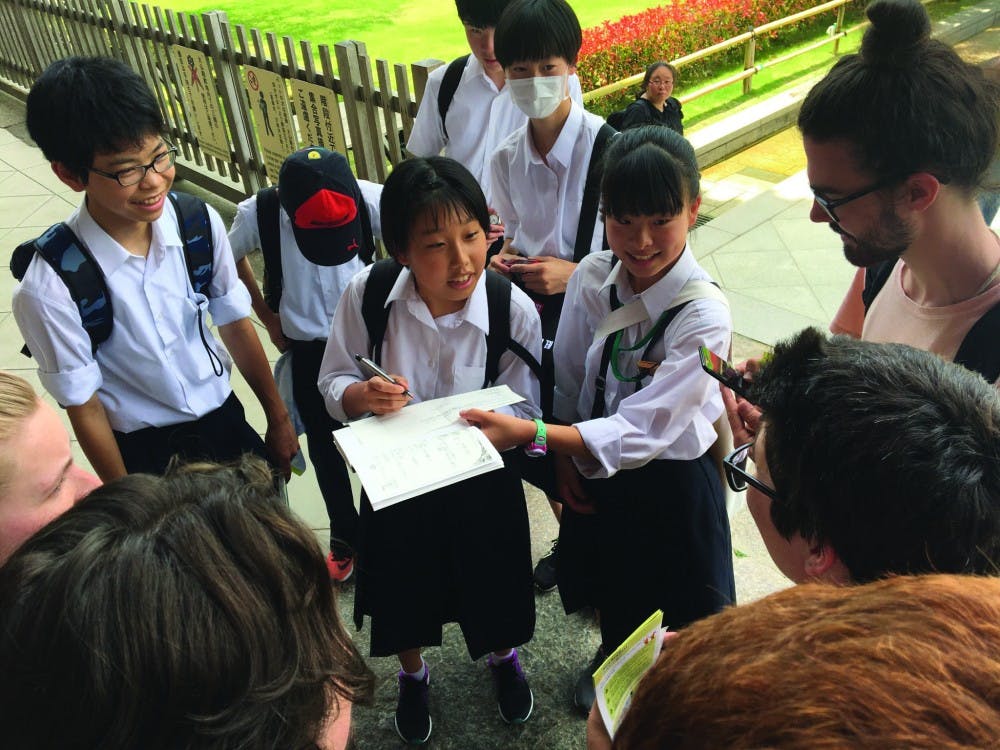Editor's note: Miles from Muncie is a Ball State Daily News series profiling Ball State students and their study abroad programs. If you have any suggestions as to who we should feature next, send an email to features@bsudailynews.com.
“If a picture is worth a thousand words, seeing a place in person must be worth a million.”
Junior architecture major Jackson Haynes said studying abroad in Japan allowed him to have first-hand experiences with the country and its culture, which he wouldn’t have been able to learn from reading a book.
Haynes and 13 other Ball State students used their senses to study Japan’s architecture and landscape design during a CAP field study from May 22 to June 10.
“This trip has allowed me to see many buildings I learned about in textbooks first hand,” said Maarten Bergsma, junior architecture major. “I was able to not only view certain details from all directions, but [also] get up close and touch them with my bare hands. Being able to walk around inside a universally celebrated space is an experience that will forever be humbling and enlightening to me.”
Miguel San Miguel, assistant professor of practice in the Department of Architecture, led the CAP field study. He said Japan is a valuable place for students to explore and critique architectural designs.
“Most of the [tourists] go to see architecture and landscapes, experience the city [and] find beauty through nature, art and sculptures,” San Miguel said. “All it takes is to find one thing a day to make it a beautiful day. So, a CAP field study is perfect for those things … because it in turn helps us as environment designers in architecture, landscape architecture, urban design, interior design or construction.”
San Miguel also said having a good understanding of another country’s history, architecture and culture ahead of time is vital for CAP field study abroad trips. The students had one week of pre-travel preparation regarding cultural topics such as tea ceremonies, technology, Buddhism, ceramics, cuisine, film and photography.
“[The pre-travel preparation] broadens horizons and expands knowledge,” San Miguel said. “It challenges preconceived notions and then allows a person the ability to build upon those ideas once in the country through first hand experience of the culture.”
Bergsma agreed with San Miguel and said exploring the different aspects of Japanese culture was what made the trip so fulfilling.
“The differences in style when it comes to fashion, architecture or food are apparent,” Bergsma said. “What really becomes interesting is coming to an understanding of the more subtle parts of [Japanese] culture, like their obsession with detail and cleanliness.”
During the field study, students sketched designs in their notebooks and listened to their professor and graduate assistant, Taylor Henderson, explain the history behind Japan’s different forms of architecture.
“Learning in Japan was more like a vacation than a class,” Bergsma said. “Every day was filled with exciting things to see and do, and keeping [a] record of my findings in my sketchbook was just another way to become excited about this very unique place.”
Besides learning, Haynes also said he and the other students were able to immerse themselves in Japanese culture in their downtown from sketching.
“They have 7-11 convenience stores everywhere so food is readily available, but this isn’t your traditional gas station stuff,” Haynes said. “The difference is that the food there is always fresh. It wasn’t uncommon to grab sushi, noodles, sandwiches and several varieties of foods at these places. The Japanese drink a lot, so many of us would go out to Izakayas, Japanese bars, for drinks every other night.”
Along with their own personal exploration, Ball State students had the chance to learn some Japanese to communicate with some of the locals who Haynes said were “polite and friendly.”
“They were just so patient and courteous during the entire length of our trip,” Haynes said. “The Japanese appreciate it when you engage yourself in their culture and try to speak their language. Many times, we would strike up short conversations in English with locals on subways or light rails. On one occasion, a Japanese man asked if we were Americans, to which we replied, ‘Yes.’ His follow-up question was, ‘Do you know Donald Trump?’ We all laughed.”
While sightseeing at tourist locations in Japan, Bergsma said Japanese middle school and high school students would interview him and the other students.
“[They would ask] us questions in English, probably to practice their English skills,” Bergsma said. “Not knowing too much of the language, I wasn’t able to do much interviewing myself.”
After returning to Muncie, students had to complete a post-travel design project. San Miguel said most people in the group designed a lantern inspired by, or as a critique, of something they experienced in Japan.
“My two landscape architecture majors focused on a landscape design for a part of the BSU campus with a technological landscape focus,” San Miguel said. “[Another student] researched and produced work with regard to photography and architecture.”
Not only did the students have the opportunity to discover and learn from Japanese architecture, but they also learned about the working world around them.
“As someone who has traveled abroad a few times now, I always return to the United States with a slightly altered view of our own society, in terms of what is good and bad,” Haynes said. “The Japanese just have this work hard, play hard mentality that is hard to describe, and it is reflected through their architecture, infrastructure, [and] public spaces. The attention to detail there is incredible.”
Contact Kamryn Tomlinson with comments at kptomlinson@bsu.edu.





